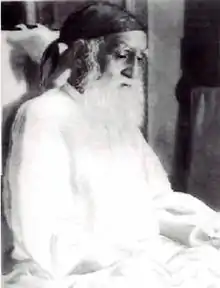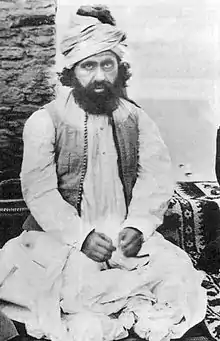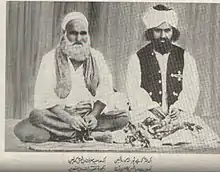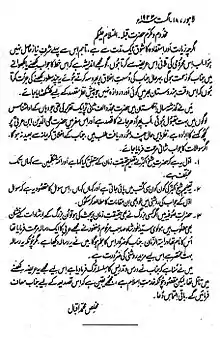Meher Ali Shah
| Part of a series on Islam Sufism |
|---|
|
|
Meher Ali Shah | |
|---|---|
 | |
| Title | Pir, Syed |
| Personal | |
| Born | 14 April 1859 (1 Ramadan 1275 A.H.) |
| Died | May 1937 (aged 78) Golra Sharif, British India (present-day Pakistan) |
| Religion | Islam |
| Children | Ghulam Mohiyyuddin Gilani |
| Parents |
|
| Order | Sufism Qadiriya Chishti Order |
| Muslim leader | |
| Based in | Golra Sharif |
| Predecessor | Sial Sharif |
| Successor | Ghulam Mohiyyuddin Gilani |
Meher Ali Shah (Urdu: پیر مہر على شاه; 14 April 1859 – May 1937), was a Sufi scholar from British India (present Day Pakistan) belonging to the Chishti order. He is known as a Hanafi scholar leading the anti-Ahmadiyya movement. He wrote several books, most notably Saif e Chishtiyai ("The Sword of the Chishti Order"), a polemical work criticizing the Ahmadiyya movement of Mirza Ghulam Ahmad.[1][2]
Shah was a descendant, on his father Nazr Din Shah's side, of Abdul Qadir Jilani in the 25th generation, and of Prophet Muhammad through Imam Hassan Ibn-e-Ali in the 38th generation. On the side of his mother Masuma Mawsufa, he descended from Abdul Qadir Jilani in the 24th generation and from Prophet Muhammad through Imam Hussain Ibn-e-Ali in the 37th generation.[3]
Education
He received his early religious education at the Khanqah (school at the mausoleum) and was given classes in Urdu and Persian in the local Madressah.[4] After completing his education at Angah at the age of 15, he decided to continue further studies in the United Provinces (U.P) of India. He therefore set out for higher education in different parts of India including Kanpur, Aligarh, and Saharanpur. His stay at Aligarh at the madrasah of Lutfullah of Aligarh was for two and a half years.[5]

Works

- Tahqiq-ul-Haq Fi Kalima-tul-Haq (The Truth about Kalima-tul-Haq)[6]
- Shamsul Hidayah
- Saif-e-Chishtiya
- I’la Kalimatillah Fi Bayan-e-Wa Ma Uhilla Bihi Legharillah
- AlFatuhat-us-Samadiyyah (Divine Bounties)
- Tasfiah Mabain Sunni Wa Shi’ah
- Fatawa-e-Mehria
- Mulfuzaat-e-Mehria (Sayings of Meher Ali Shah)
- Fight against Ahmaddiya Movement
Religious beliefs

Shah was a disciple and Khalifa of Khawaja Shams-ud-din Sialvi of Sial Sharif in the Silsila-e-Chishtia Nizamiyah.[7][8] His biography Meher-e-Muneer records that he was also made a khalifa by Imdadullah Muhajir Makki, when he visited the latter in Mecca.
Shah was a supporter of Ibn Arabi's ideology of Wahdat-ul-Wujood but he made a distinction between the creation and the creator (as did Ibn Arabi).[9] He also wrote explaining the "Unity of Being" doctrine of Ibn Arabi.
Like his comrade Qazi Mian Muhammad Amjad, he was an authority on Ibn Arabi and his 37-volume work The Meccan Illuminations (Al-Futūḥāt al-Makkiyya).
In 1933, Shah was absorbed in his meditation and mystic trances. That year the philosopher Muhammad Iqbal had to give a lecture at Cambridge University on Ibn Arabi's concept of Space and Time. He wrote a letter to the Shah stating that now there was nobody in all of Hindustan whom he could consult in this matter, and requesting him to tell about Ibn Arabi's work. The Shah however, due to his meditation and bad health, could not reply.[10]

Historic mosque's construction
In the old city of Rawalpindi, a historic Mughal style mosque (Central Jamia Masjid) was built in 1903 as a symbol of Muslim unity in the Potohar region with donations by Rawalpindi's Muslim community. This mosque was completed in two years and was inaugurated by the Sufi saint of Golra Sharif, Pir Meher Ali Shah along with the deposed king of Afghanistan Ayub Khan who was living in Rawalpindi at the time.[11]
Prominent Muslim figures of the Pakistan Movement such as Maulana Zafar Ali Khan, Attaullah Shah Bukhari and Maulana Anwar Shah Kashmiri later led prayers at this historic mosque, when they visited it.[11]
Death
In the early part of the month of Safar 1356-A.H (April 1937), he had an attack of cold, which soon developed into typhoid fever, which lasted for several days. His condition grew worse during the last days of Safar. On the morning of 29 Safar (11 May 1937), the pulse became irregular and the body temperature also underwent sudden changes.
Just before the arrival of the final irrevocable moment, he pronounced the words “Allah” from the deepest recesses of his heart in a manner which sent a shudder throughout his body from head to foot, and the reverberation of which was felt by every one who happened to touch the body. The next moment, he repeated the word “Allah” a second time and then turned his head towards the Qibla, thus signaling that the end had finally come.[12]
His three-day Urs (annual death anniversary) is held every year from 27th to 29th Safar. Thousands of devotees come from all over Pakistan to visit the tomb of this early twentieth century Punjabi mystic sufi poet, Pir Meher Ali Shah.[13]
Honors
- Pakistan Post issued at commemorative postage stamp in its Sufi saint series (2013) to pay tribute to him.[14][15]
- Pir Mehr Ali Shah Arid Agriculture University located at Murree Road Rawalpindi is named after him.[16]
See also
References
- Meher e Muneer. pp. 203–257.
- Mihr-e-munīr: Biography of Ḥaḍrat Syed Pīr Meher Alī Shāh ( in English). GoogleBooks website.
- Mihr-e-munīr: Biography of Ḥaḍrat Syed Pīr Meher Alī Shāh ( in English). GoogleBooks website.
- "Early Life and education". The Light of Golra Sharif.
- ul Haq Gilani, Ghulam Qutub. "Early life and Education". The Light of Golra Sharif.
- Tahqiq ul Haq Fi Kalimatil Haq. Maqtab Golra Sharif.
- Hasan, Mushirul (1993). Khwaja Shamsuddin Sialvi. Oxford University Press. p. 204.
- "Disciples of Khwaja Shamsuddin Sialvi". Sial Sharif.
- Mulfuzaat -e- Mehrya by Meher Ali Shah
- "Mehr Muneer" a Biography of Meher Ali shah by Maulana Faiz Ahmed
- "Central Jamia Masjid - a 115-year-old symbol of Muslim unity". Dawn (newspaper). 4 June 2018. Retrieved 22 November 2019.
- Mihr-e-munīr. p. 296.
- Umer Draz (7 April 2010). "Yesterday once more". The Express Tribune (newspaper). Retrieved 22 November 2019.
- "Postage stamp on Pir Meher Ali Shah". The News International. 30 July 2013.
- "Pir Meher Ali Shah (Sufi Saint Series) Commemorative Postage Stamp July 30, 2013". Pakistan Post.
- Aamir Yasin (1 May 2019). "Arid varsity being run by deputy registrar after retirement of pro-VC". Dawn (newspaper). Retrieved 22 November 2019.
